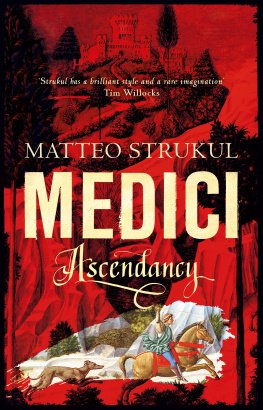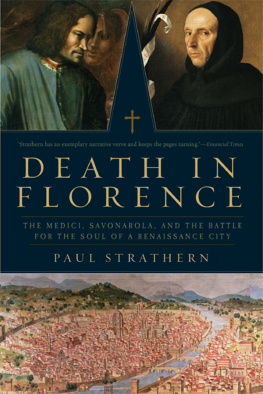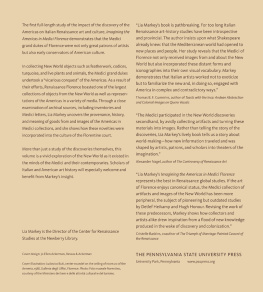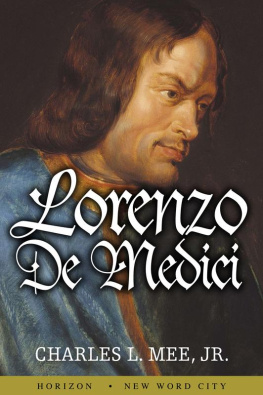A LTHOUGH THERE are very many books on the lives and times of the Medici, not since the appearance of Colonel G.F. Youngs two-volume work in 1909 has there been a full-length study in English devoted to the history of the whole family from the rise of the Medici bank in the late fourteenth century under the guidance of Giovanni di Bicci de Medici to the death of the last of the Medici Grand Dukes of Tuscany, Gian Gastone, in 1737. This book is an attempt to supply such a study and to offer a reliable alternative, based on the fruits of modern research, to Colonel Youngs work, which Ferdinand Schevill has described as the subjective divagations of a sentimentalist with a mind above history.
I cannot pretend to be an expert in any of the wide-ranging fields covered in the book; and I am, of course, deeply indebted to those writers and scholars upon whose publications I have been able to rely. I would like to mention in particular Sir Harold Acton, Miss Eve Borsook, Professor Eric Cochrane, Mr Vincent Cronin, Professor J.R. Hale, Dr George Holmes, Professor Lauro Martines, Marchesa Iris Origo, Marchese Ridolfi, Professor Raymond de Roover, Professor Nicolai Rubinstein and Mr Ferdinand Schevill. I am also extremely grateful to Dr Brian Moloney of the Department of Italian in the University of Leeds and to Dr George Holmes of St Catherines College, Oxford, for having read the book in proof and for having made several valuable suggestions for its improvement. Parts of the book have also been read by Signor Fabio Naldi who has been good enough to place his wide knowledge of Tuscan topography and architecture at my disposal. For their great kindness and help when I was working in Florence I want to thank Signorina Patrizia Naldi and the staffs of the Biblioteca Nazionale Centrale and of the Museo di Firenze Com Era.
For their help in a variety of other ways I am much indebted to Dr Roberto Bruni, Mrs Maurice Hill, Mrs Geraldine Norman, Conte Francesco Papafava, Mrs John Rae, Mrs Joan St George Saunders, Mr Meaburn Staniland and the staffs of the British Museum, the London Library and the Bodleian Library, Oxford.
Finally I want to say how grateful I am, once again, to my friends Mr Hamish Francis and Mr George Walker for having read the proofs, and to my wife for having compiled the index.
C.H.
FLORENCE AND THE FLORENTINES

A Florentine who is not a merchantenjoys no esteem whatever
O NE SEPTEMBER morning in 1433, a thin man with a hooked nose and sallow skin could have been seen walking towards the steps of the Palazzo della Signoria in Florence. His name was Cosimo de Medici; and he was said to be one of the richest men in the world. As he entered the palace gate an official came up to him and asked him to wait in the courtyard: he would be taken up to the Council Chamber as soon as the meeting being held there was over. A few minutes later the captain of the guard told him to follow him up the stairs; but, instead of being shown into the Council Chamber, Cosimo de Medici was escorted up into the bell-tower and pushed into a cramped cell known as the Alberghettino the Little Inn the door of which was shut and locked behind him. Through the narrow slit of its single window, so he later recorded, he looked down upon the city.
It was a city of squares and towers, of busy, narrow, twisting streets, of fortress-like palaces with massive stone walls and overhanging balconies, of old churches whose faades were covered with geometrical patterns in black and white and green and pink, of abbeys and convents, nunneries, hospitals and crowded tenements, all enclosed by a high brick and stone crenellated wall beyond which the countryside stretched to the green surrounding hills. Inside that long wall there were well over 50,000 inhabitants, less than there were in Paris, Naples, Venice and Milan, but more than in most other European cities, including London though it was impossible to be sure of the exact number, births being recorded by the haphazard method of dropping beans into a box, a black bean for a boy, a white one for a girl.
For administrative purposes the city was divided into four quartieri and each quartiere was in turn divided into four wards which were named after heraldic emblems. Every quartiere had its own peculiar character, distinguished by the trades that were carried on there and by the palaces of the rich families whose children, servants, retainers and guards could be seen talking and playing round the loggie , the colonnaded open-air meeting grounds where business was also discussed.
The busiest parts of the city were the area around the stone bridge, the Ponte Vecchio, which spanned the Arno at its narrowest point and was lined on both sides with butchers shops and houses;into the shape of lions, the heraldic emblem of the city. Animals roamed everywhere: dogs wearing silver collars; pigs and geese rooting about in doorways; occasionally even a deer or a chamois would come running down from the hills and clatter through the square.
Not many years before, though Dante had denounced their luxurious manners, the Florentines seem to have frowned upon any untoward display of wealth. They had dressed very simply, the standard costume for all men who were artisans being an ankle-length gown of dark-coloured cloth, buttoned down the front like a cassock. Their houses, too, had been unassuming. Even those of the richest families had been furnished with plain wooden tables and the most uninviting beds. The walls were generally whitewashed, tapestries being unpacked from chests to be displayed on special occasions only; floors were of bare stone, rarely covered with anything other than reed matting; the shuttered windows were usually made of oiled cotton. Glass and majolica ornaments were few and discreet; silverware was produced from the sideboard, or from a locked cupboard in the masters room, for none but the honoured guest; and few families yet had forks. In more recent years, however, though the Florentines continued to enjoy a reputation for frugality, they had become noticeably less abstemious and restrained. The stone houses of the well-to-do still presented a severe, even forbidding appearance to the street; but behind the glazed and curtained windows of the upper storeys, the rooms were frequently carpeted, the walls painted with murals, hung with tapestries, religious pictures and occasionally concave looking-glasses to reflect light onto a table or desk. Fireplaces were much more common so that on cold winter nights warming-pans and scaldini earthenware jars filled with hot charcoal were not so necessary. Much of the furniture was painted or decorated with marquetry. The canopied beds, standing on raised platforms and surrounded by footboards, were very large often twelve feet wide big enough for four people or even more to sleep in them side by side, lying naked beneath the linen sheets and breathing in air made sweet by scent or by herbs burning slowly in pierced globes hanging from the ceiling.
Over their trunk hose and jacket men still wore the lucco , the dark ankle-length gown with long, wide sleeves and a hood attached to the neck; but many young men now preferred more gaily coloured clothes a pink cape, perhaps, worn with a satin jacket, white stockings shot with silver lace, a velvet cap with a feather in the brim, scented gloves, golden rings and a golden chain, a jewelled dagger and a sword. There were sumptuary laws as there were elsewhere in Europe; but no one paid them much attention. Certainly the women did not. An official, who was ordered to compel women to obey the laws, submitted a characteristic report of his failure:



















